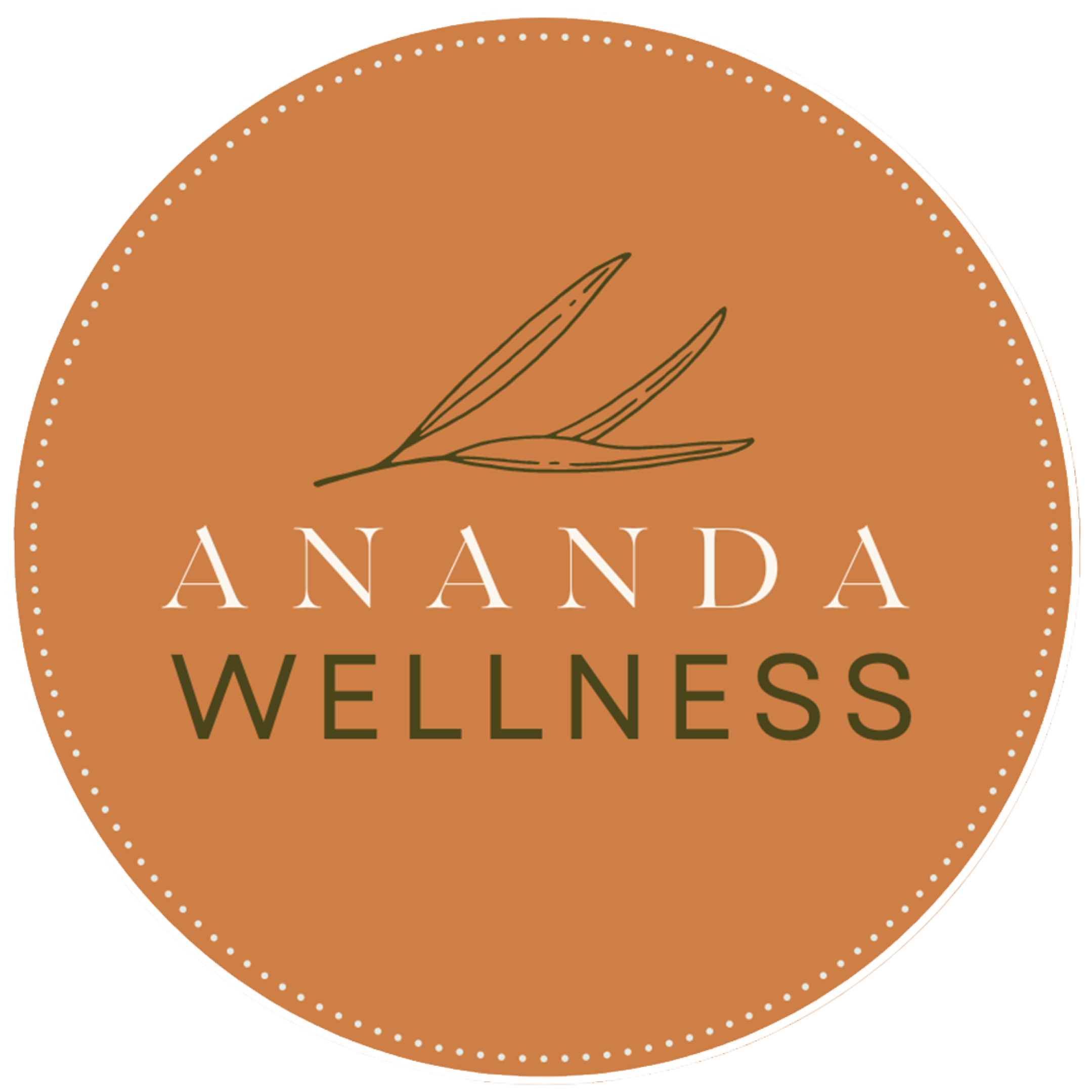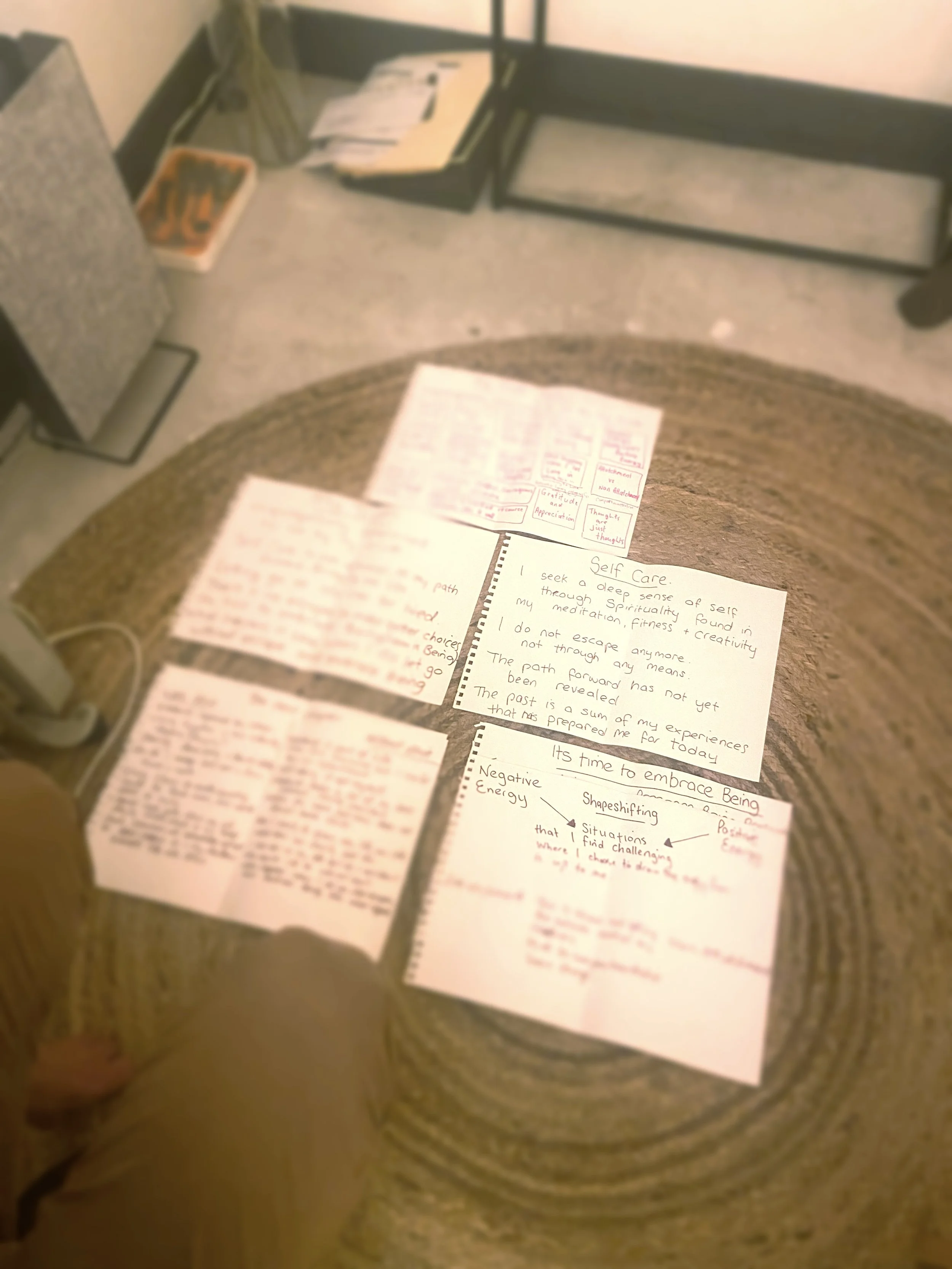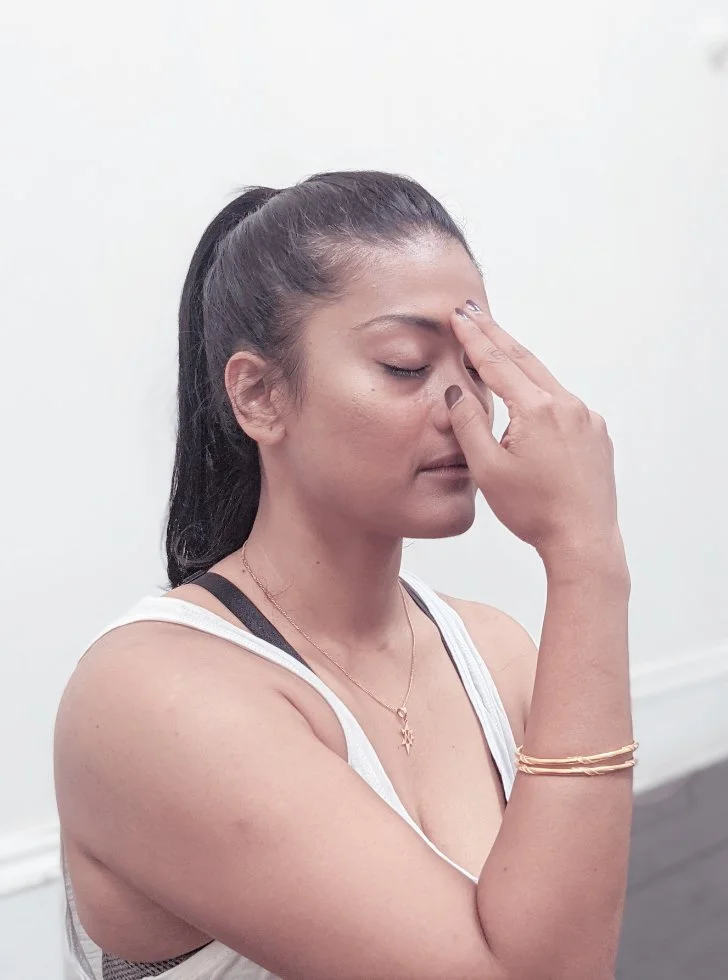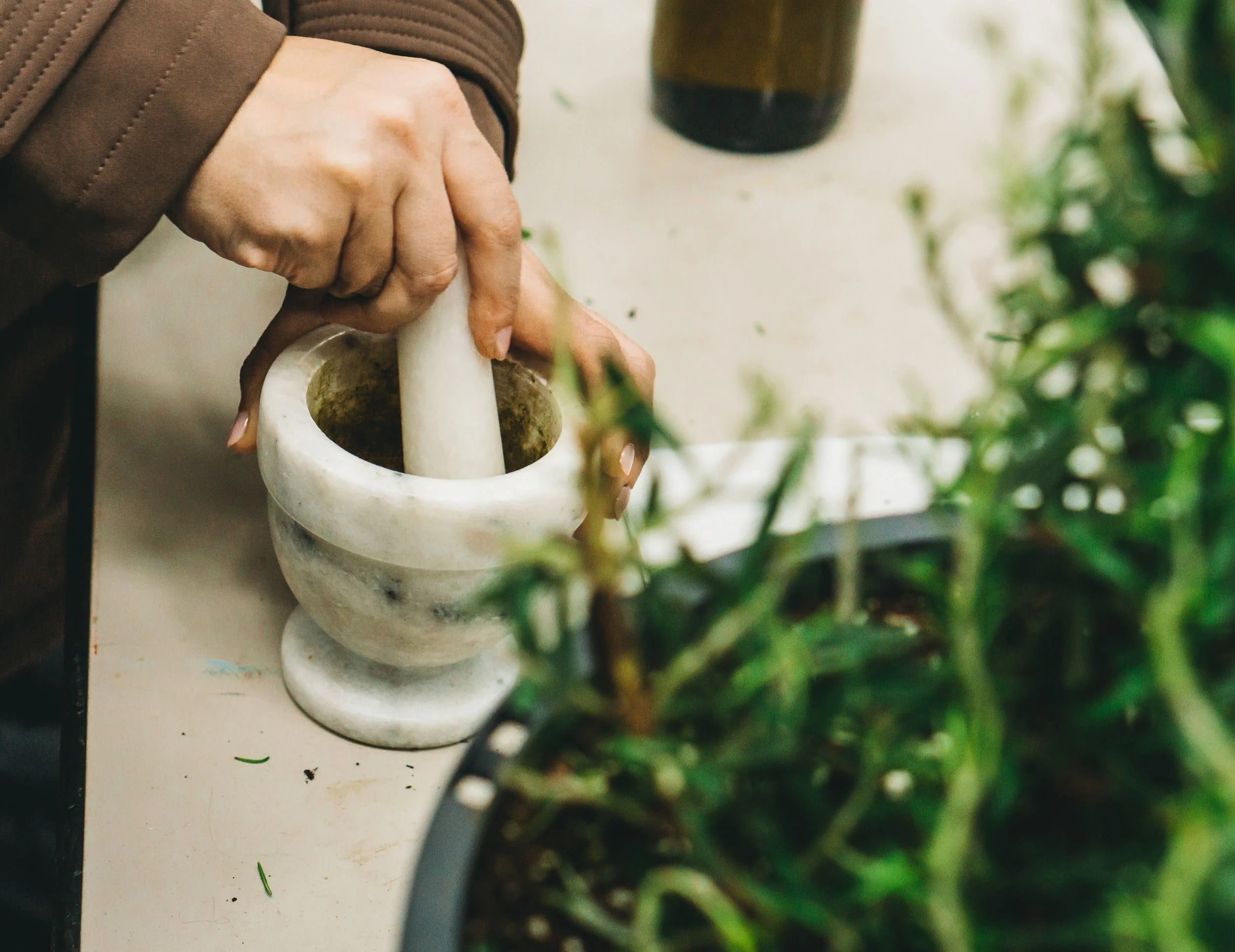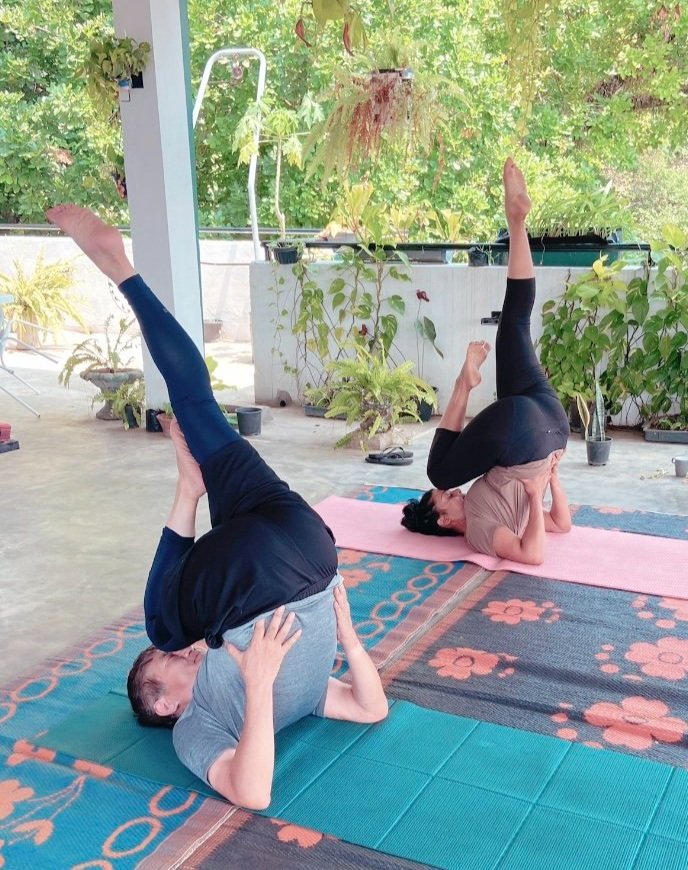Combining kriyas with classic hatha asana (posture) and pranayama (breath)
This asana here is Ardha Baddha Padmottanasana (Half Bound Lotus Standing Forward Bend) that stretches the muscles in the lower back, hip, hamstrings, and shoulders. It is derived from the Sanskrit words Ardha=half, Baddha=bound, Padma=lotus, Uttana=intense stretch, and asana=pose. This is an intense forward bend pose that is in the combination of Ardha Padmasana and Uttanasana. To build up to it, start to practice half lotus and standing forward bends and then begin to combine them, starting by wrapping the arm around the body before progressing to reaching for the foot. A great way to develop balance, stability and flexibility. It activates the solar plexus chakra, and stimulates the ajna and crown chakras due to the inversion.
According to the Hatha yoga pradipika, Surya bhedi pranayama or right nostril breathing is one of the most beneficial pranayama (breath work) techniques in activating and energising the body. In Ayurveda too, this pranayama technique is used to dispel a kapha vitiation leading to lethargy, sluggishness, low energy, low motivation and a feeling of dullness.
The focus of this pranayama technique is to activate the surya or ‘sun’ element in your body, via the right nostril and ‘Pingala’ nadi which aligns with the vitality of the sun.
Read MoreThis past long weekend brought with it a great opportunity to rest, refresh and rejuvenate. I used this time to take a break from the hustle and bustle of my everyday life by nourishing my hair and skin; practicing some much needed self-care using incredible Ayuverdic herbs and simple kitchen ingredients.
Practicing acts of care like this are truly essential to come back to ourselves and honour the temples that are our bodies.
For a scalp treatment I used a blend of amla powder, shatavari powder and gingelly oil.
Read MoreDeveloping alternate pathways or themes and mapping these out can help to understand what areas in our lives need attention and what is already working well to guide our energy and resources to where it is needed most.
This is some of narrative therapy in action, supported by the ancient wisdom of the sutras (an area of interest for some clients in particular). This technique can be particularly helpful for those struggling with Anxiety, Attachment issues, Attention-deficit/hyperactivity disorder (ADHD), Depression, Eating disorders, Grief, Post-traumatic stress disorder (PTSD).
Read MoreAlternate nostril breathing (From Asana Pranayama Mudra Bandha by Swami Satyananda Saraswati)
These techniques have a calming effect and relieve anxiety, improves concentration and stimulates ajna chakra. The ratio 1:1 in stage 1 establishes a calming rhythm for the brain and heart, assisting people with cardiovascular and nervous disorders specifically, and stress-related conditions generally. As the count is extended, the breath slows down. The respiration becomes more efficient because the air flow is smoother and less turbulent. This ratio helps people with respiratory problems such as asthma, emphysema and bronchitis.
Read MoreKapha aggravations can impact the health of the kidneys, lungs, mucus membranes, bladder, fluid content. It can lead to swellings, heaviness and accumulations of mucus in the body. It increased by the salty, sour and sweet tastes e.g. salt, citrus fruits and refined sugars. Kapha is decreased by pungent, bitter and astringent tastes (e.g. turmeric, bitter green, black tea, ginger).
Here is a sample meal plan, herbs and spices to consider in winter months.
Read MoreAyurvedic wisdom places a significant focus on the connection between nature’s seasons and the doshic balance within us. Staying mindful of the time of year and adjusting your routine can help to keep imbalances at bay.
The key is proactively managing the elemental balance that fluctuates in each season. For instance, pitta dosha increases in late spring as the weather warms up and we start to approach summer season, so you’d incorporate more cooling foods and lifestyle practices. Similarly, while we might have been managing vata dosha through early to mid autumn, we’d now slowly shift gears as the weather becomes cooler, wetter and more earthy at the end of Autumn nearing the approach of winter in Australia next month (June).
Read MoreOn my most recent trip to Sri Lanka I attended one of my mum’s yoga classes and learned this fantastic asana to help activate the ajna chakra, which is located between the eyebrows and is indigo in colour.
It governs insight, intuition and the function of brain, ears, eyes and the hypothalamus, which works with the pituitary gland to secrete and regulate a number of hormones. When it is at its full potential you are more able to stay calm under pressure, think more clearly and decisively, become more self aware and able to tap into your gut voice and intuition. It brings deep calm and steadiness.
Read MoreWe have all had moments that we’ve been triggered by a situation or person leading to an intense emotional response (sometimes ones we regret). Some are skilled or mindful enough to let that response be what it truly is – an emotion. They experience it, acknowledge it, allow it to dissipate. In the absence of this mindful processing or regulation that emotional response usually escapes, becoming a reaction. It is in this stage or the ‘heat of the moment’ that we can say or do things we may later regret.
Read MoreExperience powerful Sri Lankan Ayurvedic herbal steam inhalation therapy and a massage / release of key marma points along with heat therapy to help you loosen the congestion and heaviness of hay fever and blocked sinuses.
Suitable for both seasonal as well as chronic conditions.
Read MoreThe Sage Patanjali says that to bring peace to the mind, watch and regulate the breath. In the practice of Hatha yoga, this is one of the main aims: to control the movement of the Prana, through breathing. To practice, begin with a deep inhalation and exhalation and then watch the breath move in and out, slowly. This is an observation of prana-apana - the force moving up is prana and the force moving down is apana. Both ayurveda and hatha yoga focus on the balance of these two forces to find equilibrium and peace
Read MoreAs we move through what seems like an endless loop of lockdowns it is easily to feel flat, disappointed, worn out and lacking motivation. Remember that not every day will be the same - today may be low, tomorrow upbeat. Remind yourself ‘this too shall pass’; remember the journey is never linear - in fact most times it is the opposite, and listen to what your body and mind are asking you to do to keep life light even in the smallest way…
Read MoreLockdown after lockdown has worn many of us out. We are over talking about it yet it’s always in every conversation. Limited movement, possibilities; tiring. One thing I have returned to whenever I can in the week is to observe nature - the tranquility that birds, insects, trees & plants seem to maintain whilst things around us, and them, change so much has a stabilising, assuring quality.
Read MoreHere is an update on the backbends I practiced recently and have been adding in to my daily practice for warming up and energising
Read MoreAmalaki (Amla) or Indian Gooseberry is a great natural source of vitamin C and one of the 3 fruits used to produce the highly revered ‘triphala’ formulation. Amla helps to manage excess pitta in the body, supporting the natural functions of the liver and the immune system
.
Amla oil or churna made into a hair pack is especially good at alleviating hair loss and early greyness. It is a renowned rejuvenative and adaptogen for slowing age (vayahsthapana), increasing virility, promoting immunity and inducing balanced health (satmikarana).
For anyone feeling anxious or a little edgy, try listening to or playing along with a Tibetan singing bowl. Simply rest the bowl loosely on the palm of your hand and strike it once, focusing on the sound and its vibration, and leaving all other thoughts aside just for that moment. Then when this fades, strike again and repeat the process, all the while allowing this vibration to displace that edginess
Read More'When ojas is low the person is fearful, weak, worried, has deranged senses, poor complexion, weak mind, is rough and thin’ (Caraka Samhita Sutrasthana 17.73). However, a person with healthy ojas is calm, content & peaceful within, has strong immunity, digestion, potent fertility and endurance. There is a sparkle in the eye and a special ‘glow’ around them.
Read MoreThe year 2020 taught us how to find peace and balance even when the answers seem totally unknown. Uncertainty and a need to know right now, to do away with the ‘grey’ is a challenge for most. So being forced to look uncertainty in the face and sit with its impact for the most part of 12 months, will have strengthened this psychic muscle.
In the spirit of venturing forth with this learning in place, here are some thoughts on intention setting and getting in ‘flow’ for 2021…
Read MorePart 2 of my post on sitting through and resetting from unpleasant feelings. (Part One is here).
To recap, we can release the ‘grip’ of unpleasant feelings that sometimes gets stuck within us and flattens us for hours or days by using awareness and release. This helps to loosen this grip within minutes by tapping into our neurobiological response whilst experiencing them and riding out the waves. The feeling of Vulnerability, Embarrassment, Disappointment, Frustration - just like this described in yesterday’s post - are usually experienced as being unpleasant and negative. In this light, most of us reach for distractions to avoid or suppress them. To help work through them a simple body scan can help at the outset, but at a deeper level it is important to acknowledge that these feelings need not necessarily or inherently be bad or negative but simply unpleasant and uncomfortable.
Read MoreIn honour of World Mental Health Day 10.10.20 I will be sharing a 2 part piece and a more specific blog post to help you identify these feelings and release them. This is part one, highlighting some of the feelings that can come up and lead us to use one or more forms of distraction to avoid or suppress them.
Read More